Peter Morgan, the creative genius behind The Crown, is the first to admit his writing is a right royal mix of fact and fantasy.
“When I write … there are the things that I want to be the case and there are the things that are the case,” he explains. “There is a constant push-pull … I’ve learnt, to my cost, that when you’re really only focused on research, the drama suffers. You have to come at it as a dramatist.
“You have to come at that almost from an emotional perspective and sort of imagine what people are feeling and thinking at this particular time rather than ‘where were they on which particular day’ and ‘what words did they use when addressing the following people in public’.”
An audience wants acts of imagination, not just historic regurgitation, Morgan argues.
But that hasn’t stopped television critics and historians from criticising how the series depicts the royal family and those swept into its orbit.
Viewers in their millions are happy to go along for the ride. But they are also hungry for facts after their intake of fantasy. Fact-checking The Crown has become such a ritual that Google sends the producers a wealth of information about what people are searching for.
To help inquisitive fans see the full picture, we’ve read biographies, scoured newspaper clippings and watched grainy television interviews. Just how much of season four is fact and how much is fiction?
Hosts with the most: (from left) Prince Edward, Prince Charles, Princess Anne, Prince Philip, Queen Elizabeth II and Prince Andrew at their Balmoral estate in 1979. Credit:Getty Images
Did the ‘Balmoral test’ exist?
The scene: Margaret Thatcher and husband Denis are invited to holiday at Balmoral, the royal estate in Scotland. On the plane there, Denis says: “Apparently, the royal family routinely subject all their guests to secret tests to find out whether someone is acceptable or not acceptable, you or non-you, part of the gang or not part of the gang.”
The truth: While there’s no evidence of a formal test, some biographers and historians have written about guests feeling discombobulated and pressured while visiting.
Prime ministers were traditionally invited to go every August. Tony Blair once called the annual pilgrimage “a vivid combination of the intriguing, the surreal and the utterly freaky”. The Queen’s biographer, Ben Pimlott, wrote that Thatcher found the trips “purgatory”.
But royal writer Hugo Vickers has said the episode is highly misleading: “The Queen and the royal family go out of their way to make their guests feel at ease at Balmoral.”
The episode does not reveal that Thatcher’s first visit to Balmoral was on September 8, 1979 – just three days after the funeral of Lord Mountbatten, whose assassination featured in episode one of the The Crown’s new season.
The producers also show Diana arriving at Balmoral just as Thatcher leaves it in 1979. In truth, Diana’s first trip to the Aberdeenshire estate was in 1980, and it was not the first time she had met the royal family.
In his book Diana: Her True Story, author Andrew Morton says Diana was “shitting bricks” about her Balmoral debut. Morton’s book is considered especially accurate because it is based on lengthy interviews with the princess.
“The ones who fail vanish from royal favour as quickly as the Highland mists come and go,” Morton wrote of Balmoral visitors.
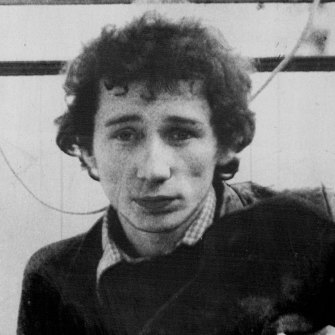
Palace prowler Michael Fagan.Credit:AP
What did Michael Fagan talk about with the Queen?
The scene: A man scales a fence at Buckingham Palace and sneaks into the Queen’s bedroom. He wakes her up and the two have a conversation about Margaret Thatcher’s controversial reshaping of Britain before a maid walks in and calls palace guards for help.
The truth: Despite widespread reporting at the time that the 33-year-old intruder had a 10-minute talk with the Queen, Fagan tells a different story. In a rare interview, Fagan told The Independent on Friday: “Nah. She went past me and ran out of the room; her little bare feet running across the floor.”
Fagan was first confronted by footman Paul Whybrew, not two guards as depicted in The Crown.
“I was scareder than I’d ever been in my life,” Fagan said of the moment the Queen saw him. “Then she speaks and it’s like the finest glass you can imagine breaking: ‘What are you doing here?!'”
Fagan never went to jail over the incident. He eventually served four years in prison after being charged with conspiracy to supply heroin in 1997. Contrary to The Crown’s sympathetic depiction of him as someone affected by Thatcher’s economic reforms, Fagan has not explained his motivation for the intrusion. “I don’t know why I did it, something just got into my head,” he told The Independent. He suggested consuming magic mushrooms in soup in early 1982 may have played a role.
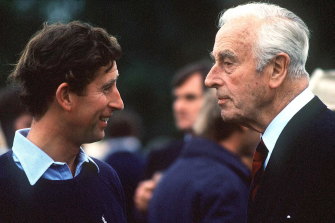
Prince Charles With Lord Mountbatten at the polo in Windsor in 1979. Credit:Getty Images
Did Lord Mountbatten really write Charles that letter on the day the IRA bomb went off?
The scene: Mountbatten – an uncle of Prince Philip who shared a close bond with Charles – writes to the future king blasting his affair with Camilla Parker-Bowles and accusing him of risking “ruin” for the royal family. Mountbatten sends the letter minutes before he is killed by a bomb planted on a fishing boat by the IRA. A grief-stricken young prince later receives the note, prompting him to pursue Diana.
The truth: This is an easy one to solve because Peter Morgan admits he made up the letter. British newspapers have quoted unnamed allies of Charles who say the depiction of such an acrimonious final exchange between the pair is particularly unfair given their affection for each other.
Morgan appears to have based the scene on letters the former Admiral of the Fleet sent Charles over previous years, including one that encouraged the young prince to “sow his wild oats” before marrying a “suitable, attractive and sweet-charactered girl”.
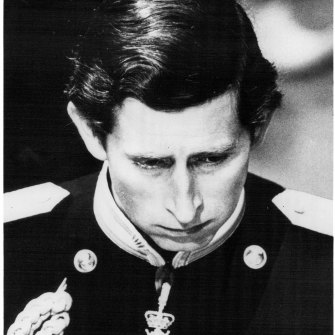
A grief-stricken Prince Charles at Mountbatten’s funeral.Credit:
In the show’s official podcast, Morgan says of the plot line: “What we know is that Mountbatten was really responsible for taking Charles to one side at precisely this point and saying, ‘Look, you know, enough already with playing the field, it’s time you got married and it’s time you provided an heir’.
Charles apparently wrote to his mentor: “I hope you are having a decent rest in Ireland and are not working unnecessarily hard.”
“In my own head I thought that would have even greater impact on Charles if it were to come post-mortem, as it were. I think everything that’s in that letter which Mountbatten writes to Charles is what I really believe, based on everything I’ve read and people I’ve spoken to, that represents his view.”
Historian Andrew Lownie believes the last letter between the pair was dated August 13, about two weeks before Mountbatten was assassinated. In that letter, Charles apparently wrote to his mentor: “I hope you are having a decent rest in Ireland and are not working unnecessarily hard.”
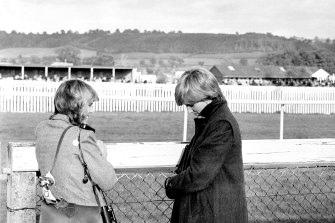
Camilla Parker-Bowles and Diana at Ludlow racecourse to watch a steeplechase in which Prince Charles was competing in 1980, the year before the royal wedding. Credit:Getty Images
Did Princess Di meet Camilla Parker-Bowles for lunch before she married Charles?
The scene: Charles’ bride-to-be meets his mistress in an excruciatingly awkward lunch at a central London restaurant named Ménage à Trois.
The truth: The duo did meet for lunch, but The Crown omits some important background information. Camilla and Diana knew each other for at least two years before the royal wedding. And Penny Junor, a highly respected royal biographer, has previously revealed that Camilla liked Diana and thought she was sweet. So the idea of a lunch is not as strange as it sounds.
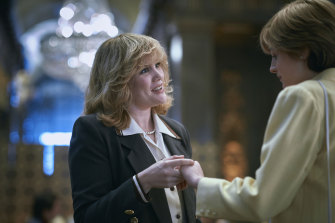
Camilla Parker-Bowles (Emerald Fennell) and Diana (Emma Corrin) meet for lunch in <i>The Crown</i>.Credit:Netflix
Diana later told her biographer that Camilla instigated the lunch in a letter in which she described the engagement as “exciting”.
“Do let’s have lunch soon when the Prince of Wales goes to Australia and New Zealand,” the letter said. “He’s going to be away for three weeks. I’d love to see the ring. Lots of love, Camilla.”
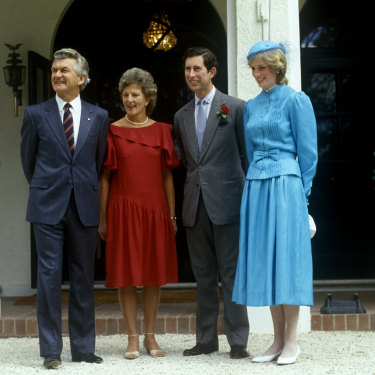
Prime minister Bob Hawke, wife Hazel and Charles and Diana in Canberra in 1983.Credit:Getty Images
Did Bob Hawke really compare the Queen to a pig?
The scene: In a television interview, then opposition leader Bob Hawke is asked how he feels about Charles and Diana. He says an Australian should be head of state, not an “unelected Pom”. “You wouldn’t put a pig in charge of a herd of prime beef cattle, even if it does look good in twin set and pearls,” he jokes.
The truth: Hawke was a committed republican but he never said this. The episode also casts Hawke as an impatient republican but he did not forcefully agitate for a republic during his early years in office.
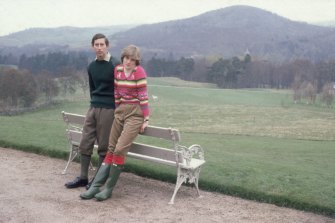
Charles and Diana at Balmoral in 1981. Credit:Getty Images
Had Charles and Diana met only a few times before they married?
The scene: The Crown suggests the pair spent very little time together before their engagement went public on February 24, 1981. At one point, Charles says he and Diana “hardly know one another”. In a later scene, Diana complains about the situation over lunch with Camilla. In an attempt to make her feel better, Camilla lists just four occasions the engaged couple have met: horse trials in the Cotswolds, a concert at the Royal Albert Hall in London, the weekend at Balmoral and a visit to Highgrove House, Charles’ country home in the west of England.
The truth: Charles first met a 16-year-old Diana Spencer at her family home, Althorp, in 1977. In The Crown, Diana is dressed like a fairy and prancing around the stately manor when she bumps into the 29-year-old heir. In reality, the setting was far less dramatic.
“We sort of met in a ploughed field,” she later said in an interview.
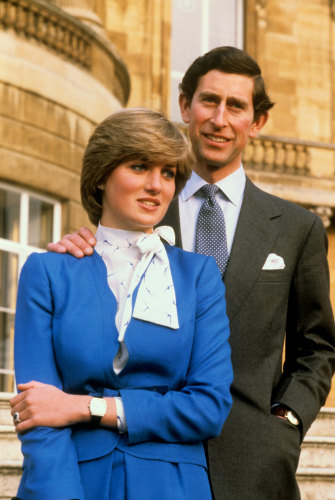
Charles and Diana pose together at Buckingham Palace after the engagement announcement.Credit:AP
They would not become romantically involved until the second half of 1980. Charles proposed at Windsor Castle on February 3, 1981. Diana told her biographer that the couple had only met 13 times before that moment.
News of the engagement was kept secret while Diana flew to Australia to holiday with her mother, Frances Shand Kydd, at a property near Yass in NSW. She returned to London later that month so the engagement could be announced publicly in a press conference in which Charles famously said he was in love with Diana, “whatever ‘in love’ means”.
Charles went on a five-week trip to Australia and New Zealand in the four months between the engagement and the lavish wedding at St Paul’s Cathedral in July that year, further reducing the time they had together before marriage.
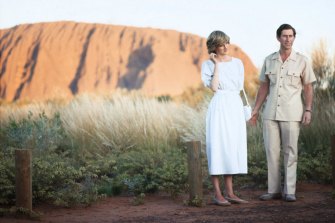
Charles and Diana at Uluru during the 1983 tour.Credit:Gerrit Fokkema
Did Princess Diana really call Uluru ‘Ayers Dock’?
The scene: At a press conference after touching down in Australia in 1983, Diana says the royal couple plan to visit ‘Ayers Dock’, prompting laughter from the media and a rebuke from Charles.
In The Crown, Diana struggles to climb up Uluru. “Can’t you pull yourself together?” an angry Charles responds.
The truth: There is no evidence Diana ever made this stumble. A search of published media articles produces no results and there is no reference to it in any biography. It appears the show’s writers included the faux pas as a creative tool to serve their depiction of Hawke pushing the case that the monarchy was out of touch with modern Australia.
Later in The Crown, Diana struggles to climb up Uluru because the heat made her dizzy. “Can’t you pull yourself together?” an angry Charles responds.
Footage from the hike does show her hesitating but a report from The Sydney Morning Herald at the time suggests it was because of the impracticality of her white dress and flat shoes.
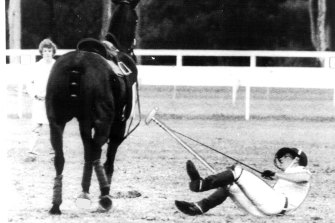
Prince Charles falls off a polo pony at Warwick Farm in Sydney.Credit:
Was Charles booed by crowds at the polo in Australia (and did he get sulky at Diana being in the spotlight)?
The scene: As a radiant Princess Diana wows crowds at a swimming event, Charles is booed while playing polo and later falls off his horse, prompting spectators to burst into laughter. The episode, Terra Nullius, also explores Charles’ apparent jealousy at his wife’s raging popularity.
The truth: Charles did fall off his horse that day, but may have been pushed by a competitor. Either way, there are no reports that the crowd ever booed during competition or cheered when he fell. He even joked about the fall during a speech at the end of the match.
With the media attention came a lot of jealousy. A great deal of complicated situations arose because of that.
The episode’s editing makes it appear as though Charles suffers the embarrassment at the same time Diana is charming the press and crowds at a swimming carnival. She did meet lifesavers during the tour – at a surf lifesaving carnival in Terrigal on the NSW central coast – but she was actually in the stands at the polo when Charles fell.
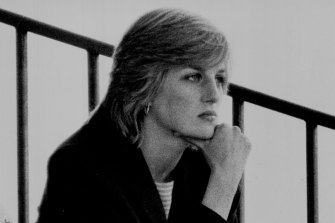
Diana watching Prince Charles play at Warwick Farm.Credit:Victor Colin Sumner
Diana later claimed Charles was often jealous of the focus on her during royal tours, including the one to Australia.
“With the media attention came a lot of jealousy. A great deal of complicated situations arose because of that,” she told her biographer.
“Everyone always said when we were in the car, ‘Oh, we’re on the wrong side, we want to see her, we don’t want to see him’ … and obviously he wasn’t used to that and nor was I. He took it out on me. He was jealous … I understood the jealousy, but I couldn’t explain that I didn’t ask for it.’
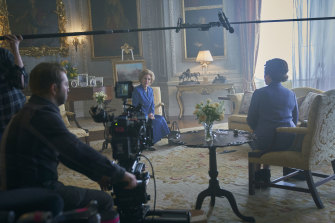
Gillian Anderson and Olivia Colman play Margaret Thatcher and the Queen.
Did the Queen and Margaret Thatcher really have a frosty relationship?
The scene: The Crown is filled with tension and awkwardness between the Queen and Britain’s first female prime minister. It implies that some of this tension comes from class differences and the Queen’s concern about the implications of Thatcher’s radical social agenda.
The truth: There were strained moments between the pair over the course of Thatcher’s 11-year premiership, but the true status of the relationship is nuanced.
The show accurately delves into a disagreement between Thatcher and the Queen over the monarch’s preference for sanctions on the South African government, and it is also true that newspapers in 1986 were filled with damaging gossip – first revealed in The Sunday Times – that the Queen was unhappy with Thatcher’s “uncaring” approach to apartheid.
Loading
But there are inaccuracies. In one scene the Queen’s private secretary, Sir Martin Charteris, pressures Buckingham Palace press secretary Michael Shea to take the fall for speaking to The Sunday Times about the Queen’s displeasure with Thatcher. Shea was certainly identified as the paper’s source but in real life Charteris had retired in 1977, nearly a decade earlier than the events depicted in The Crown.
What the series only hints at is the Queen’s admiration for Thatcher. The monarch awarded the former prime minister the Order of the Garter and the Order of Merit. She also attended Thatcher’s funeral in 2013, an honour she had bestowed on only one other former prime minister: Winston Churchill.







